PretensT
Tensegrity is a special kind of structure made of push and pull.
Project maintained by elastic-interval Hosted on GitHub Pages — Theme by mattgraham
The Tension Triangle
These structures, like the prefab tension one I made a few weeks ago are made up of triangles of tension.
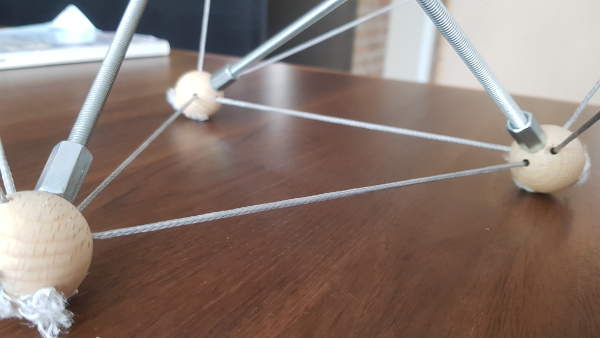
But this time we’re going to look at doing the tension differently. All that really has to happen is that the three connections being pushed apart by the compression must be held together somehow. Let’s try doing it with radial tension instead:

The shape will be the same, but it will be interesting to see how it behaves when under stress.
Perforated Aluminum
I happened upon a useful raw material for this kind of project when I was browsing the Metal Store in the south of Rotterdam. My eyes automatically skip over everything rectangular and square (yuck!) when I’m glancing around, because I only register triangles, and hexagons.
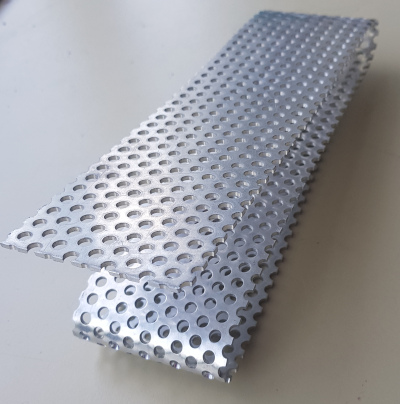
So when I was near the metal-cutting machine, I saw a big collection of left-overs, but the perforated aluminum caught my eye. It was triangular, it was hexagonal, it could have been made by a hive of aluminum bees!
Left-overs are of course cheap so I got this strip for very little.
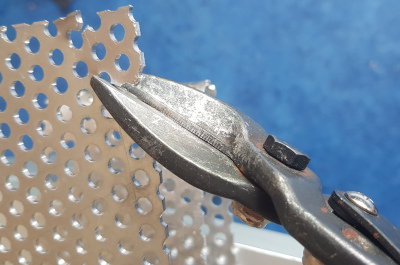
Aluminum is, as I found out, the ideal material for this kind of construction. It’s quite soft and malleable so you can cut it easily, and then file it smooth without much effort, and even bend it. Yet, as you’ll see, it is more than strong enough to hold the tension we need here.
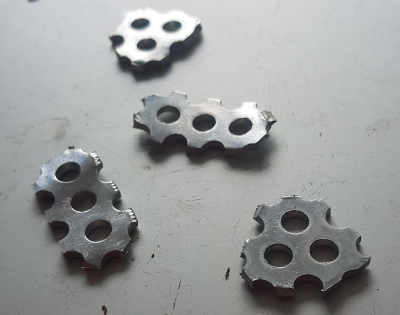
I cut groups of three holes, both in the triangular shape, and with three holes in a row.
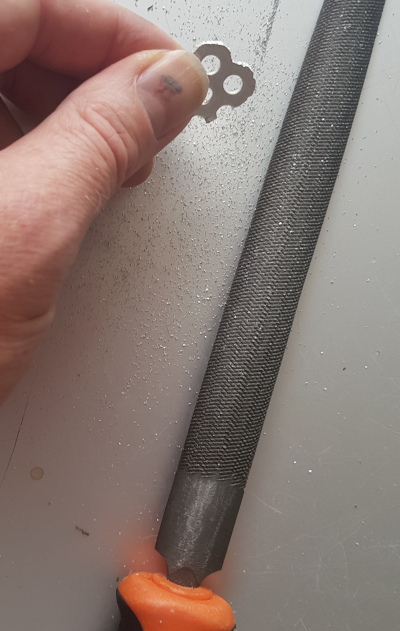
Then I filed them until they had the right shape and no sharp edges. After a while you can’t tell that it originally came from a perforated aluminum sheet, because it looks like a very nice connector, just right for the purpose.
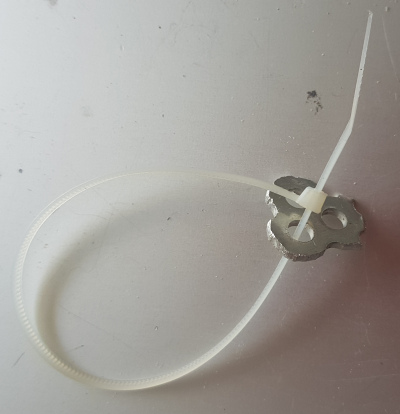
There’s just one more essential ingredient, the tie-wrap. Tie wraps easily fit through the holes and can then be tightened very precisely, basically click-by-click if you want to count the clicks you make, so that means accurate to the millimetre.
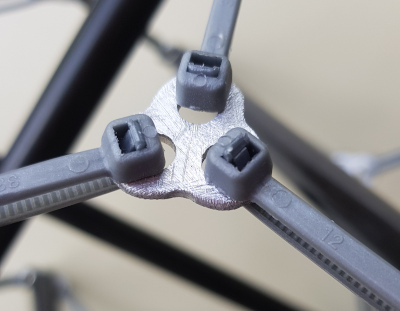
The center of the radial tension is one of these triangular-shaped aluminum connectors, and that’s where the tie wraps meet.

The three-in-a-row connectors I was able to slip over the end of a set of bars I had laying around. The middle hole went over the bar’s end and was held by the rubberish covering of these bars. I think these bars were once rollers of some kind of machine, not sure, but they have nice stainless steel bars.

Putting it all together, we once again get the six-bar tensegrity but this time with radial tension instead of triangular to hold the sets of three end points together.
Conclusion
The triangular tension model, when stressed, exhibits a rotating action which Bucky Fuller talked about at length. Every triangle rotates together or none of them rotate.
Not this one!
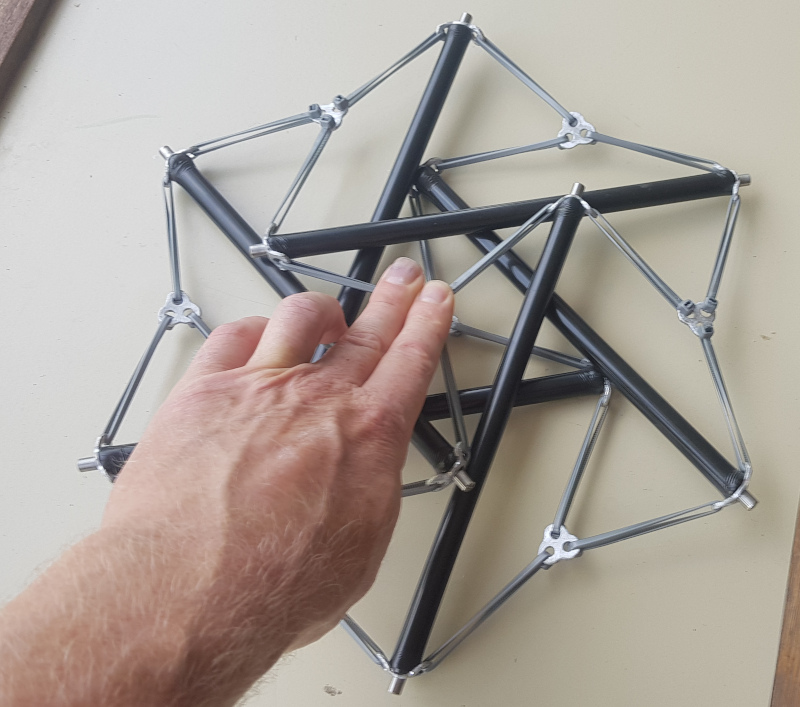
So, as expected, with radial tension the bars are suspended in space the same way as with triangular tension, but the behavior is very different!
When stressed, this version of the 6-strut tensegrity can be easily flattened. The omni-rotation that you get used to with these 6-strut tensegrities is completely absent!.
Sometimes we might think of replacing the tension triangles with something, perhaps with a fabric triangle. This experiment makes me realize that a fabric triangle would behave very differently, because it would be a middle ground between the original and this one.
Projects:
2024-07-23: "Bouncy Wooden Sphere": what you can do with a discarded bed2024-04-23: "Twisted Torque": tied into a permanent twist
2023-03-27: "Easy 30-Push Sphere": one simple element
2022-10-05: "Glass and LED": going big and colorful
2022-09-29: "Fascia": dancing with tensegrity
2022-08-30: "Mitosis": the four-three-two tensegrity
2022-08-04: "Push Bolts for the People": finalizing design and getting it out there
2022-06-22: "Head to Head Push Bolt": M5 and M6 bolts symbiosis
2022-05-30: "Hiding Knots": bump up the aesthetics
2022-05-25: "Innovation with 3D Printer": the push bolt
2021-12-02: "Headless Hug": breaking a rule for the sake of symmetry
2021-10-28: "Rebuilding the Halo": finally got it right
2021-10-20: "Convergence": growing and reconnecting
2021-07-27: "120-Strut Brass Bubble": taking the next step up in complexity
2021-05-26: "30-Strut Brass Bubble": bouncing spherical tensegrity
2021-04-08: "Bow Tie Tensegrity": better bend resistance
2021-03-29: "Six Twist Essential": what if more hands could see?!
2021-01-25: "Minimal Tensegrity": no more tension lines than absolutely necessary
2021-01-18: "Degrees of Freedom": first adjustable hybrid tensegrity
2021-01-11: "Fractal Experiment": a tensegrity of tensegrities
2020-12-09: "Axial Tension": pretensing what is already pretenst
2020-11-02: "Halo by Crane - Part 2": the strengthening
2020-10-26: "Halo by Crane - Part 1": assembly complete but strength lacking
2020-10-12: "Brass and Tulips": a tight and strong tensegrity tower
2020-08-10: "Prefab Tension Tower": the tower of eight twists
2020-07-27: "Elastic Bubble": building with elastic ease
2020-07-13: "The Twist Sisters": left-handed and right-handed
2020-07-06: "Radial Tension": Pulling towards the middle
2020-06-22: "Diamond of Tension": Four pulls for every push
2020-06-15: "Prefab Tension": Separating compression from tension